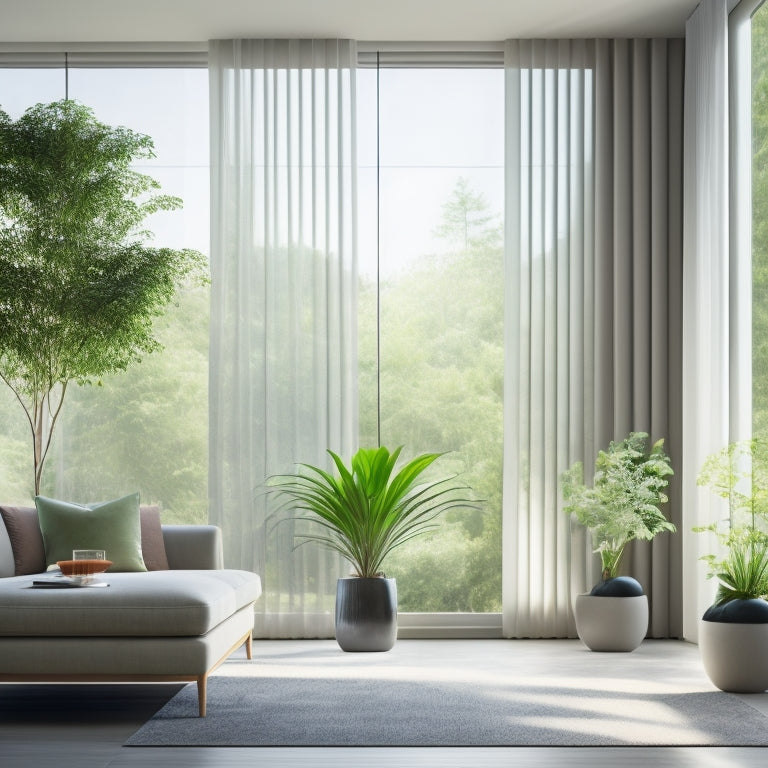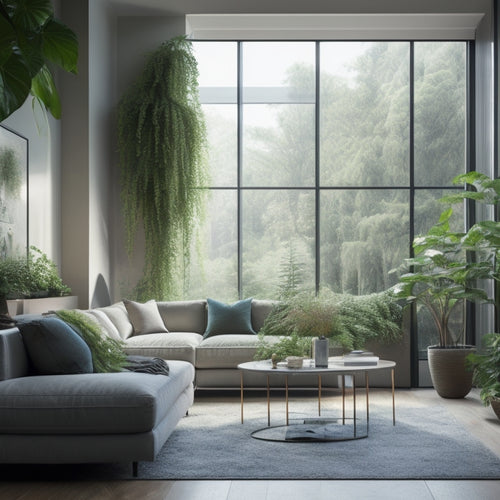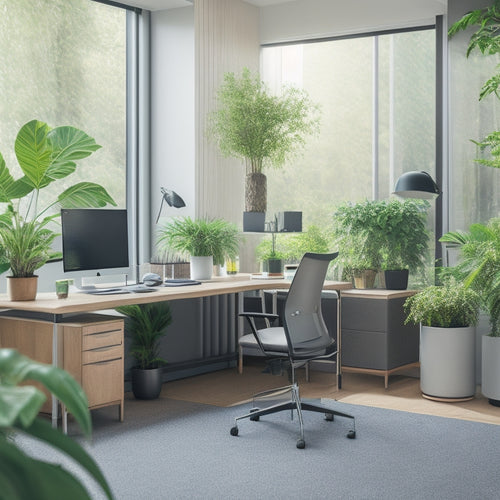
7 Earth-Conscious Tips for Automated Window Treatments
Share
By incorporating automated window treatments into your home, you can greatly reduce your environmental footprint and energy consumption. To start, optimize natural light exposure by adjusting treatments seasonally and using light diffusion techniques. Then, reduce heat gain in summer by closing shades during peak sun hours and insulating with shades. You can also automate for energy efficiency, employ sustainable materials, and integrate with renewable energy sources. Additionally, minimize energy consumption by using smart sensors and timers, and monitor energy usage remotely to make data-driven decisions. As you investigate these earth-conscious tips, you'll uncover even more ways to create a sustainable living space that's good for you and the planet.
Key Takeaways
- Optimize natural light exposure by adjusting window treatments seasonally to reduce energy consumption and heat gain.
- Utilize sustainable materials, such as recycled fabrics, bamboo, and organic cotton, for automated window treatments.
- Integrate automated window treatments with renewable energy sources, like solar panels, to maximize clean energy usage.
- Implement data-driven energy management through remote monitoring and real-time tracking to make informed decisions.
- Automate window treatments to minimize energy consumption, reduce heat gain, and promote thermal comfort.
Optimize Natural Light Exposure
When it comes to optimizing natural light exposure, your window treatments play an essential role in utilizing the sun's energy while minimizing heat gain and glare.
By implementing light diffusion techniques, you can distribute natural light evenly throughout your space, reducing harsh direct sunlight and creating a more comfortable environment.
To maximize energy production, consider optimizing your solar panel array design, including the tilt, sizing, and orientation solar panel array.
As the seasons change, make seasonal adjustments to your window treatments to maximize natural light exposure. During winter, open your treatments to let sunlight warm your space, and during spring and fall, adjust them to filter the sun's rays.
Reduce Heat Gain in Summer
You can notably reduce heat gain in your home during the summer months by taking a few key steps with your automated window treatments.
By leveraging high-efficiency solar panels smart charging station design, you can reduce your reliance on the grid and lower your energy costs.
First, block direct sunlight from entering your home by closing your shades or blinds during the hottest parts of the day.
Additionally, you can insulate with shades and reflect heat away from your windows to keep your home cooler and more energy-efficient.
Block Direct Sunlight
Direct sunlight streaming through your windows can turn your home into an oven during the summer months, making your air conditioner work overtime. Blocking direct sunlight is vital to reduce heat gain and keep your home cool.
Regular maintenance of solar panels, including cleaning and inspecting connections, is essential for optimizing performance and ensuring longevity, as regular cleaning of solar panels can prevent up to 20% efficiency loss solar panel maintenance.
To block direct sunlight effectively, consider the following:
- Install light filtering window treatments that allow natural light in while reducing glare and heat gain.
- Use automated window treatments with built-in glare reduction features to minimize direct sunlight.
- Close your window treatments during peak sun hours (usually between 11 am and 3 pm) to prevent direct sunlight from entering your home.
- Consider using solar screens or window films to block direct sunlight and reduce heat gain.
- Adjust your window treatments according to the time of day and season to maximize energy efficiency.
Insulate With Shades
During the sweltering summer months, your windows can be a major culprit in heat gain, allowing warmth to seep into your home and drive up your cooling costs. By insulating with shades, you can reduce heat gain and maintain thermal comfort. This is especially important during seasonal adjustments when the sun is high in the sky.
| Shade Type | Heat Gain Reduction |
|---|---|
| Light-blocking shades | 75% |
| Cellular shades | 60% |
| Pleated shades | 50% |
| Solar shades | 40% |
| Room-darkening shades | 30% |
Reflect Heat Away
Heat-absorbing windows can turn your home into an oven, making it difficult to stay cool and comfortable. You can reduce heat gain in the summer by using heat reflection techniques with your automated window treatments. This will help keep your home cool and energy-efficient.
For instance, large-scale solar farms can generate electricity specifically for powering EV charging stations, and energy storage systems allow excess solar energy to be stored for use during low sunlight periods solar energy generation. Similarly, homeowners can integrate solar energy for EV chargers, contributing to personal sustainability efforts.
Use window treatment materials with high reflectivity, such as aluminum or silver-backed fabrics, to bounce heat away from your windows. Install solar shades with a reflective coating to reduce heat gain. Apply a low-e window film to reflect heat and keep your home cool. Choose light-colored window treatments to reflect heat and reduce absorption.
Consider using automated awnings or overhangs to block direct sunlight and reduce heat gain.
Minimize Energy Consumption
With automated window treatments, you can greatly reduce your energy bills by minimizing energy consumption.
By integrating smart sensors, you can optimize your energy usage and stay within your energy budgets. These sensors detect the amount of natural light entering your space and adjust your window treatments accordingly, reducing the need for artificial lighting.
Furthermore, with the increasing adoption of renewable energy sources, homeowners can further reduce their carbon footprint.
In addition, automated window treatments can learn your daily routines and preferences, ensuring that your energy consumption is minimized when you're not home or when the sun is shining brightly.
Utilize Sustainable Materials Only
You're not only reducing your energy bills with automated window treatments, but you're also contributing to a more sustainable future.
When selecting materials for your automated window treatments, prioritize eco-friendly options that align with your values.
Consider the following sustainable materials:
- Recycled fabrics that reduce waste and conserve natural resources
- Bamboo materials that are highly renewable and require minimal water and pesticides
- Organic cotton grown without toxic chemicals or synthetic fertilizers
- Eco-friendly finishes that are free from harsh chemicals and toxins
- Biodegradable options that can easily decompose at the end of their life cycle, reducing waste and environmental impact
Integrate With Renewable Energy
Take your automated window treatments to the next level by utilizing the power of renewable energy.
By integrating your system with solar panels, you'll capture clean energy to power your window treatments, reducing your reliance on the grid and minimizing your carbon footprint.
Confirm your system is compatible with your smart home setup to optimize energy collection and usage.
With solar panel integration, you'll enjoy increased energy independence and lower utility bills.
Plus, many governments offer incentives for renewable energy adoption, so be certain to investigate available credits and rebates.
Automate for Energy Efficiency
Most homeowners can agree that energy efficiency is a top priority when it comes to their automated window treatments.
You can optimize energy efficiency by automating your window treatments to work in tandem with your home's natural lighting and temperature. Here's how:
-
Use smart sensors to detect the amount of natural light entering your home and adjust your window treatments accordingly.
-
Set automated timers to open and close your window treatments during peak sunlight hours to reduce the need for artificial lighting.
-
Program your window treatments to close during extreme temperatures to reduce heat gain or loss.
-
Integrate your window treatments with your HVAC system to optimize energy efficiency.
-
Consider using energy-efficient materials for your window treatments, such as thermal blackout shades or solar screens.
Monitor Energy Usage Remotely
With remote monitoring capabilities, you can keep track of your automated window treatments' energy usage from anywhere, at any time.
This smart monitoring feature allows you to stay on top of your energy consumption, making adjustments as needed to optimize your energy efficiency.
Through energy tracking, you can identify areas of improvement and make data-driven decisions to reduce your carbon footprint.
Whether you're at home, in the office, or on-the-go, you can access real-time data on your energy usage, giving you the freedom to take control of your energy consumption.
Frequently Asked Questions
Can Automated Window Treatments Be Powered by Solar Panels?
You can utilize solar energy efficiency by powering your automated window treatments with solar panels, ensuring a sustainable design that reduces your carbon footprint and gives you freedom from traditional energy sources.
Do Eco-Friendly Window Treatments Cost More Than Traditional Ones?
You'll find that eco-friendly window treatments, like Lutron's sustainable shades, often cost more upfront, but they'll save you money in the long run with significant energy savings and sustainability benefits, paying for themselves over time.
Can I Control Automated Window Treatments With Voice Commands?
You can control your automated window treatments with voice commands by ensuring voice command compatibility and smart home integration, allowing you to seamlessly operate your shades with popular voice assistants like Alexa or Google Assistant.
Are Motorized Shades Compatible With Older Homes' Wiring?
You're not stuck in the dark ages - motorized shades can work in older homes, but you might need wiring upgrades or retrofitting options to make it happen, so don't worry, you'll be controlling those shades in no time!
Can I Install Automated Window Treatments Myself or Require a Professional?
You can attempt a DIY installation, but consider seeking professional assistance to guarantee a seamless process, especially if you're not familiar with electrical work; weigh the cost considerations and follow installation tips to avoid common mistakes.
Related Posts
-

Why Merge Earth's Heat With Sun's Energy?
You're about to utilize the full potential of renewable energy by combining the Earth's natural heat with the Sun's a...
-

Why Vertical Gardens Reduce Home Energy Consumption
By incorporating a vertical garden into your home design, you'll reduce energy consumption through natural insulation...
-

What Air Purifiers Save Energy in Work Areas?
You can cut energy costs and reduce your carbon footprint by choosing air purifiers designed with energy efficiency i...


